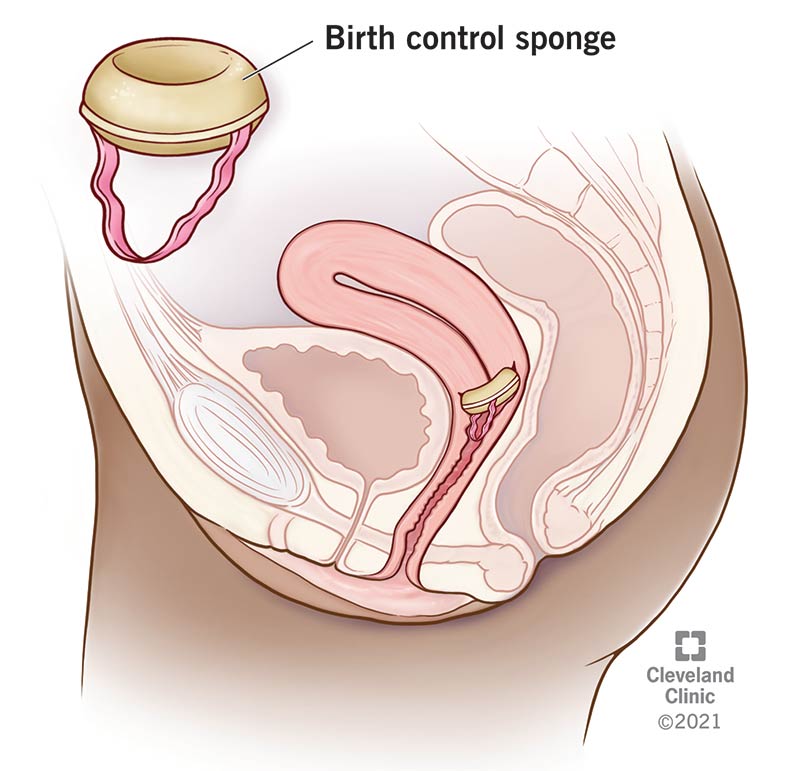The birth control sponge is a contraceptive (birth control) device. It’s placed inside your vagina just before sex to help prevent pregnancy. The birth control sponge is also called the contraceptive sponge or “the sponge.”
Advertisement
Cleveland Clinic is a non-profit academic medical center. Advertising on our site helps support our mission. We do not endorse non-Cleveland Clinic products or services. Policy

The birth control sponge is a small, round, soft piece of plastic (polyurethane) foam that’s coated with spermicide. You insert it into your vagina before having sex. It covers your cervix and helps prevent sperm from reaching your uterus.
Advertisement
Cleveland Clinic is a non-profit academic medical center. Advertising on our site helps support our mission. We do not endorse non-Cleveland Clinic products or services. Policy
People who want a hormone-free birth control option could benefit from the sponge. It’s also a good option for people who want to buy birth control without a prescription. Keep in mind, you should always talk with your healthcare provider before making any decisions about your reproductive health.
Yes. Though the birth control sponge was taken off the market in 1994 – and again in 2008 – it was reintroduced for a second time in 2009.
The birth control sponge was introduced in 1983, but was discontinued in 1994 after FDA inspectors discovered bacterial contamination at its manufacturing plant. The sponge reemerged in 2005 under new ownership. The new owners promoted the product and then sold it to another company – a business that went bankrupt in 2007. A new distributor picked up the birth control sponge in 2009, and the product has been sold nationwide since then.
The birth control sponge helps prevent pregnancy in a few different ways. The sponge:
You can insert the birth control sponge up to 24 hours before having sex. The process takes a bit of preparation compared to other types of birth control:
Advertisement
Once you insert the sponge, you can have sex multiple times before removing it.
You must wait at least six hours after having sex to remove the birth control sponge. However, don’t leave it in for more than 30 hours.
When you’re ready to remove your contraceptive sponge:
The sponge is about 88% effective for women who’ve never given birth. For those who have given birth, the sponge is about 80% effective. These estimates are based on perfect use every time.
In comparison, condoms are 98% effective when used properly, and birth control pills are 99% effective when used properly. For this reason, it’s a good idea to combine the sponge with other forms of birth control if you want maximum pregnancy prevention.
Here are some of the most notable birth control sponge advantages:
The biggest disadvantage of the birth control sponge is that it doesn’t protect you against sexually transmitted diseases and infections (STDs & STIs). Additionally, the spermicide in the sponge may cause:
Advertisement
Remember, there are several birth control sponge pros and cons to consider. Ask your healthcare provider for more information.
It’s a good idea to talk with your healthcare provider before deciding whether or not to use the birth control sponge. But you should definitely consult with them if you’ve recently given birth, had a miscarriage or had an abortion.
Some partners may be able to feel the sponge during sex. However, the sponge is made from a soft material that mimics normal vaginal tissue – so most people don’t even know that it’s there.
Choosing the best birth control method is important – and what’s right for someone else may not be right for you. It’s important to discuss all options with your healthcare provider so you can make an informed decision about your reproductive health.
Advertisement
Your birth control needs to work for you. At Cleveland Clinic, we help you find the right birth control option to fit your goals and lifestyle.

Last reviewed on 10/21/2022.
Learn more about the Health Library and our editorial process.